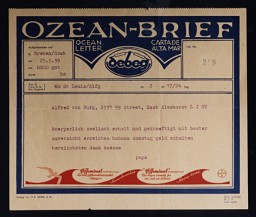You searched for: 代谷歌竞价霸屏推广靠谱【TG飞机:@bapingseo】库拉索引流神器【TG电报:@bapingseo】信息流代全世界推广开户【Telegram:@bapingseo】ag真人官方网爱博盘口官方?1oCspd/m2PRVf.html
<< Previous | Displaying results 161-170 of 959 for "代谷歌竞价霸屏推广靠谱【TG飞机:@bapingseo】库拉索引流神器【TG电报:@bapingseo】信息流代全世界推广开户【Telegram:@bapingseo】ag真人官方网爱博盘口官方?1oCspd/m2PRVf.html" | Next >>
-
Norbert Wollheim describes forced labor at the Buna works
Oral HistoryNorbert studied law and was a social worker in Berlin. He worked on the Kindertransport (Children's Transport) program, arranging to send Jewish children from Europe to Great Britain. His parents, who also lived in Berlin, were deported in December 1942. Norbert, his wife, and their child were deported to Auschwitz in March 1943. He was separated from his wife and child, and sent to the Buna works near Auschwitz III (Monowitz) for forced labor. Norbert survived the Auschwitz camp, and was liberated by US…
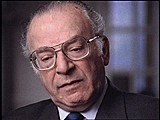
-
Dachau survivors at liberation
PhotoCamp survivors crowded in barracks at liberation. Dachau, Germany, April 29-May 1, 1945.
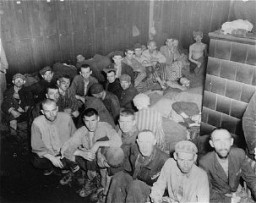
-
Adolf Hitler's authorization for the Euthanasia Program
PhotoAdolf Hitler's authorization for the Euthanasia Program (Operation T4), signed in October 1939 but dated September 1, 1939.
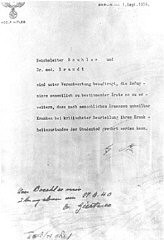
-
Father Charles Coughlin
PhotoFather Charles Coughlin, leader of the antisemitic Christian Front, delivers a radio broadcast. United States, February 4, 1940.
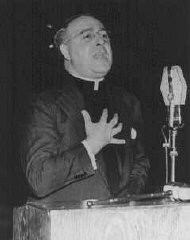
-
A refugee collapses
PhotoAn exhausted Jewish woman from the Exodus 1947 refugee ship is given a drink as British soldiers stand nearby. The British forcibly returned the passengers to Europe. Haifa, Palestine, July 19, 1947.
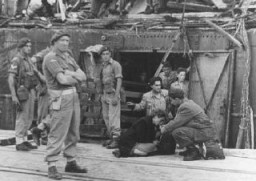
-
Page from volume 5 of a set of scrapbooks documenting the German occupation of Denmark
ArtifactPage from volume 5 of a set of scrapbooks compiled by Bjorn Sibbern, a Danish policeman and resistance member, documenting the German occupation of Denmark. Bjorn's wife Tove was also active in the Danish resistance. After World War II, Bjorn and Tove moved to Canada and later settled in California, where Bjorn compiled five scrapbooks dedicated to the Sibbern's daughter, Lisa. The books are fully annotated in English and contain photographs, documents and three-dimensional artifacts documenting all…

-
Ruth Webber describes the bitterness that she felt after the end of the war when she was in an orphanage in Krakow
Oral HistoryRuth was four years old when the Germans invaded Poland and occupied Ostrowiec. Her family was forced into a ghetto. Germans took over her father's photography business, although he was allowed to continue working outside the ghetto. Before the ghetto was liquidated, Ruth's parents sent her sister into hiding, and managed to get work at a labor camp outside the ghetto. Ruth also went into hiding, either in nearby woods or within the camp itself. When the camp was liquidated, Ruth's parents were split up.…
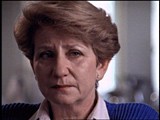
-
American Jewish Congress
ArticleThe American Jewish Congress led anti-Nazi protest rallies in the 1930s and 1940s. Learn about the AJC's creation, leadership, activities, and rescue efforts.

-
1939: Key Dates
ArticleExplore a timeline of key events during 1939 in the history of Nazi Germany, World War II, and the Holocaust.
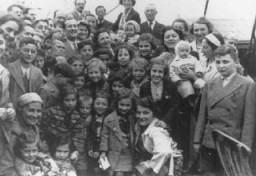
-
Radiogram from Moritz Schoenberger on the "St. Louis"
DocumentOn May 25, 1939, artist Moritz Schoenberger sent this radiogram (a telegram sent by radio) from the ocean liner "St. Louis" during the voyage from Hamburg, Germany, to Havana, Cuba. On this voyage, the "St. Louis" carried over 900 Jewish refugees fleeing Nazi persecution. The telegram reads, in part, "Physically and spiritually recovered and invigorated most confident about reaching Havana Saturday. Money received. Many thanks. Kisses. Papa." Schoenberger's optimism proved unfounded. Cuban authorities…
